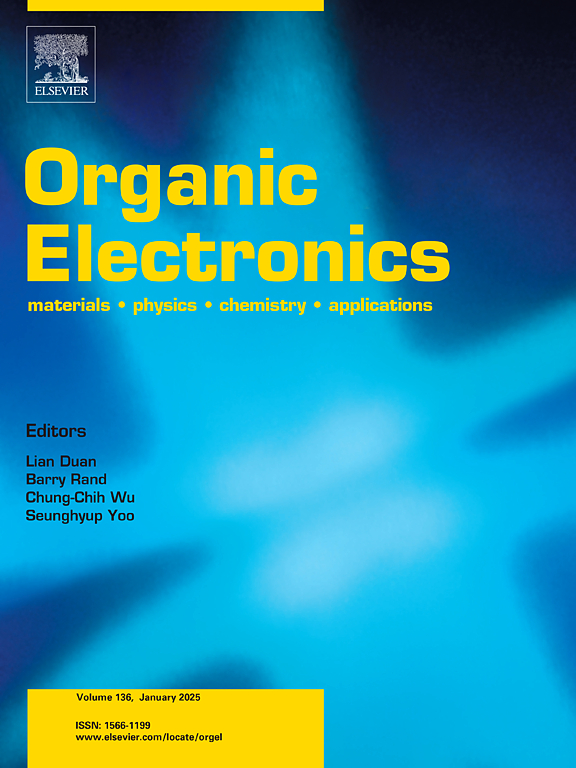Low-voltage RGB perovskite light-emitting transistors with magnetron sputtered Ta2O5 high-k dielectric layer
IF 2.6
4区 工程技术
Q3 MATERIALS SCIENCE, MULTIDISCIPLINARY
引用次数: 0
Abstract
Perovskite light-emitting transistors (PeLETs) represent an emerging class of optoelectronic devices that integrate the exceptional light-emission capabilities of perovskite light-emitting diodes (PeLEDs) with the efficient charge transport properties of field-effect transistors (FETs). This integration facilitates simplified fabrication, enhanced current densities, and stable charge mobility, making PeLETs highly promising for advanced display applications. Low-voltage operation and full-color emission are the primary challenges in achieving high-performance PeLETs. In this work, a PeLET structure that operates at 5 V is designed using a magnetron-sputtered Ta2O5 high-k dielectric layer. The influence of the hole transport layer's energy level structure and mobility on the performance of the light-emitting transistor is investigated. By tuning the perovskite bandgap, the PeLETs with emission in the red, green, and blue spectral regions have been achieved. The optimized red-, green-, and blue-emitting PeLETs exhibit charge carrier mobilities of 0.41 cm2V−1s−1, 1.00 cm2V−1s−1, and 0.51 cm2V−1s−1, with corresponding threshold voltages of 0.27 V, 0.64 V, and 0.46 V, respectively. This work advances the development of PeLETs by demonstrating a multilayer device architecture that enhances charge carrier dynamics and expands emission tunability. These findings provide a promising path toward low-voltage PeLETs for next-generation display technologies.

具有磁控溅射Ta2O5高k介电层的低压RGB钙钛矿发光晶体管
钙钛矿发光晶体管(PeLETs)是一类新兴的光电器件,它将钙钛矿发光二极管(PeLEDs)的卓越发光能力与场效应晶体管(fet)的高效电荷传输特性结合在一起。这种集成有助于简化制造,增强电流密度和稳定的电荷迁移率,使PeLETs在高级显示应用中非常有前途。低压操作和全彩发射是实现高性能PeLETs的主要挑战。在这项工作中,使用磁控溅射Ta2O5高k介电层设计了工作在5v的PeLET结构。研究了空穴输运层的能级结构和迁移率对发光晶体管性能的影响。通过调整钙钛矿带隙,可以获得在红、绿、蓝光谱区域发射的PeLETs。优化后的红色、绿色和蓝色PeLETs的载流子迁移率分别为0.41、1.00和0.51 cm2V−1s−1,相应的阈值电压分别为0.27 V、0.64 V和0.46 V。这项工作通过展示一种多层器件架构来推进PeLETs的发展,该架构增强了载流子动力学并扩展了发射可调性。这些发现为下一代显示技术的低压PeLETs提供了一条有希望的道路。
本文章由计算机程序翻译,如有差异,请以英文原文为准。
求助全文
约1分钟内获得全文
求助全文
来源期刊

Organic Electronics
工程技术-材料科学:综合
CiteScore
6.60
自引率
6.20%
发文量
238
审稿时长
44 days
期刊介绍:
Organic Electronics is a journal whose primary interdisciplinary focus is on materials and phenomena related to organic devices such as light emitting diodes, thin film transistors, photovoltaic cells, sensors, memories, etc.
Papers suitable for publication in this journal cover such topics as photoconductive and electronic properties of organic materials, thin film structures and characterization in the context of organic devices, charge and exciton transport, organic electronic and optoelectronic devices.
 求助内容:
求助内容: 应助结果提醒方式:
应助结果提醒方式:


